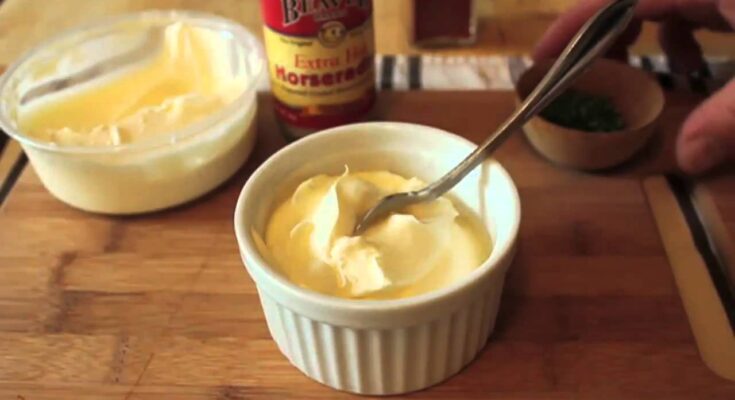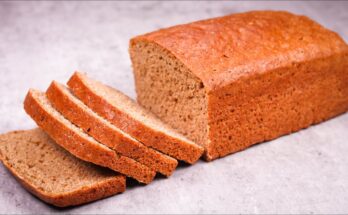Horseradish Recipe: Horseradish is one of those ingredients that can instantly transform a dish. With its sharp, fiery bite, it delivers a heat that’s quite different from chili peppers—it hits the nose more than the tongue, almost like a wake-up call for your taste buds. This root vegetable, often overlooked in modern kitchens, has been a staple condiment for centuries. Its unique flavor and pungency make it perfect for pairing with meats, mixing into sauces, or adding a zesty kick to salads.
What is Horseradish?
Horseradish is a root vegetable from the Brassicaceae family, the same group that includes mustard, wasabi, and cabbage. Its long, white root is the part used in cooking, and when freshly grated, it releases compounds that create that familiar sinus-clearing heat. Interestingly, horseradish itself doesn’t taste spicy until it’s cut or grated—this is when enzymes react and release its sharp aroma.
A Brief History of Horseradish in Cooking
Horseradish has been cultivated for over 3,000 years, dating back to ancient Egypt. It was later embraced in European cuisines, especially in Germany, Poland, and Russia, where it became a traditional part of holiday feasts. In Jewish cuisine, horseradish is often eaten during Passover as a bitter herb, symbolizing the hardships endured by ancestors. Today, it remains popular worldwide as both a condiment and an ingredient in sauces.
Why Make Homemade Horseradish?
Store-bought horseradish often lacks the punch of a freshly prepared version. Making it at home ensures maximum flavor and allows you to control the heat, texture, and seasoning. Plus, it’s incredibly simple and requires only a few ingredients. Fresh horseradish will always deliver a more vibrant, nose-tingling bite than anything sitting on a grocery store shelf.
Ingredients You’ll Need
Making horseradish at home doesn’t require a long list of complicated ingredients. In fact, you only need a few basic items, but the freshness and balance are what make all the difference.
Fresh Horseradish Root
This is the star of the recipe. Look for firm, white roots without blemishes. Avoid roots that feel soft or look dry and shriveled. The fresher the root, the more potent the flavor.
Vinegar – The Essential Preservative
Vinegar not only balances the sharpness of horseradish but also acts as a preservative. White vinegar is most commonly used, though apple cider vinegar can add a slightly fruity note.
Salt and Sugar for Balance
A pinch of salt enhances the flavor, while a touch of sugar helps mellow the intense heat. These are optional, but they make a big difference in achieving a well-rounded taste.
Optional Flavor Boosters
- Lemon juice for brightness
- Mustard for extra sharpness
- Beet juice for a vibrant pink color
- Garlic for added depth
Tools and Equipment Required
You don’t need a professional kitchen setup to prepare horseradish at home, but a few tools will make the process much easier.
Knife and Peeler
Used to clean and peel the horseradish root. Since the root is quite tough, a sturdy knife is essential.
Food Processor or Grater
A food processor is the easiest way to achieve a fine, consistent texture. If you prefer, a box grater works just as well—though be warned, it can be eye-watering work!
Airtight Jars for Storage
Glass jars with tight-fitting lids are best for storing horseradish. They help lock in freshness and prevent the strong aroma from escaping into your fridge.
Step-by-Step Guide to Making Horseradish
Now that you’ve gathered your ingredients and tools, it’s time to bring everything together. The process is straightforward but requires careful handling since horseradish can be very pungent once grated.
Step 1 – Preparing the Horseradish Root
Wash the root thoroughly under cold water, scrubbing away any dirt. Peel off the tough outer skin using a vegetable peeler or knife. Cut the root into small chunks that will be easier to grate or process.
Step 2 – Grating or Processing
If using a food processor, pulse the horseradish chunks until finely grated. If using a hand grater, grate into a bowl. Work in a well-ventilated area, as the fumes can be intense. You may even want to open a window or wear goggles if you’re sensitive.
Step 3 – Adding Vinegar and Seasoning
Immediately after grating, add vinegar to preserve the flavor and prevent browning. The timing of when you add the vinegar determines the heat level—adding it right away keeps it mild, while waiting a few minutes before mixing makes it spicier. Stir in salt and sugar to taste.
Step 4 – Storing Your Horseradish
Transfer the mixture into clean, airtight jars. Store in the refrigerator, where it will keep for about 3–4 weeks. For longer storage, consider freezing small portions.
Tips and Tricks for Perfect Horseradish
Making horseradish at home may sound simple, but there are a few insider tips that can take your recipe from average to restaurant-quality. The trick lies in handling its strong aroma, balancing the heat, and storing it properly so it stays fresh for as long as possible.
Handling the Pungent Aroma
If you’ve ever cut into a fresh onion and felt your eyes burn, horseradish takes that sensation up a notch. As soon as the root is grated, it releases volatile compounds that can make your eyes water and even clear your sinuses. To minimize discomfort, always work in a well-ventilated kitchen. Open a window, turn on your stove’s exhaust fan, or even step outside while grating if possible. Some people even wear protective goggles when preparing large batches. Another tip is to grate smaller amounts at a time, which helps keep the fumes under control.
Adjusting the Heat Level
The beauty of making horseradish at home is that you control the spiciness. The timing of when you add vinegar plays a huge role. If you add vinegar immediately after grating, the horseradish stays mild. If you wait 2–3 minutes before adding vinegar, the heat level increases significantly. Want an extra kick? Let it sit a little longer before sealing it with vinegar. Remember, once the vinegar is added, the chemical reaction that produces the heat stops.
Extending Shelf Life
Homemade horseradish doesn’t last forever, but you can extend its freshness with a few tricks. Always store it in an airtight glass jar to keep oxygen out and preserve its pungency. Make sure your utensils and jars are clean and dry before filling them—moisture can lead to mold growth. For longer storage, divide the horseradish into small portions and freeze them in ice cube trays. That way, you can thaw only what you need without spoiling the rest.
Serving Suggestions
Horseradish is more versatile than most people think. Sure, it’s a classic condiment for roast beef or steak, but it can also sneak its way into sauces, dressings, and traditional dishes across the globe. Its bold flavor has the power to brighten up almost any savory recipe.
As a Condiment for Meats
One of the most common ways to enjoy horseradish is alongside beef, pork, or lamb. Its sharp bite cuts through rich, fatty meats, balancing flavors beautifully. Roast beef sandwiches, prime rib dinners, and even grilled sausages come alive with a spoonful of fresh horseradish. If you’re into seafood, horseradish also pairs perfectly with oysters, smoked salmon, and shrimp cocktails.
Mixing into Sauces and Dressings
Horseradish is often blended into mayonnaise, sour cream, or yogurt to create creamy dipping sauces. This is especially popular for serving with fried foods, roasted potatoes, or vegetable platters. A spoonful of horseradish can also be stirred into salad dressings to add a subtle kick. And let’s not forget the legendary Bloody Mary cocktail—it wouldn’t be the same without that spicy horseradish zing.
Adding to Traditional Dishes
Different cultures have their own unique ways of using horseradish. In Eastern European cuisine, it’s often mixed with beets to create a vibrant, slightly sweet condiment. In Jewish tradition, it plays an important role during Passover. Meanwhile, in American kitchens, horseradish sauce has become a beloved side for holiday feasts, especially Christmas dinners.
Health Benefits of Horseradish
Besides being delicious, horseradish is surprisingly healthy. It’s one of those condiments that packs a nutritional punch without adding unnecessary calories. By incorporating it into your diet, you’re not just enhancing flavor—you’re also boosting your health.
Rich in Antioxidants
Horseradish contains compounds like glucosinolates, which are known for their antioxidant properties. These help protect your cells from damage caused by free radicals. Eating foods high in antioxidants may reduce the risk of chronic diseases, including heart disease and certain cancers.
Natural Immune Booster
The pungent compounds in horseradish are more than just strong flavors—they actually have antibacterial properties. Traditionally, horseradish has been used as a natural remedy for colds and respiratory issues. Its ability to clear nasal passages and fight bacteria makes it a natural choice for boosting the immune system.
Digestive Aid
Horseradish stimulates the production of digestive enzymes, which can help your body break down food more efficiently. It’s also low in calories and high in fiber, making it a great addition to a balanced diet. Some studies even suggest it may promote liver health and detoxification.
Common Mistakes to Avoid
Like any recipe, preparing horseradish at home comes with a few pitfalls. Avoiding these mistakes will ensure your horseradish turns out flavorful, fresh, and long-lasting.
Using Old Roots
The freshness of the root makes a huge difference. Old, dried-out horseradish roots won’t deliver the strong flavor you’re looking for. Always choose firm, white roots with no signs of mold or shriveling.
Adding Vinegar Too Early
Adding vinegar immediately after grating will stop the heat reaction before it fully develops. Unless you want a mild flavor, wait a few minutes before sealing it with vinegar. This simple step can make the difference between a weak horseradish and one that truly packs a punch.
Improper Storage
Leaving horseradish exposed to air or using unclean containers will cause it to spoil faster. Always use airtight glass jars and refrigerate promptly. Also, avoid double-dipping with dirty utensils, as this introduces bacteria that can reduce shelf life.
Variations of Horseradish Recipes
One of the best things about horseradish is how adaptable it is. While freshly prepared grated horseradish has its own fiery charm, you can tweak it into several variations that suit different tastes and dishes. From creamy spreads to colorful condiments, these variations will keep your meals exciting.
Creamy Horseradish Sauce
If you find fresh horseradish too strong on its own, turning it into a creamy sauce is a fantastic option. Combine grated horseradish with sour cream, mayonnaise, or Greek yogurt. Add a splash of vinegar, salt, and a little sugar to balance the flavors. The result is a smooth, tangy, and slightly spicy sauce that pairs beautifully with roast beef, baked potatoes, or even as a sandwich spread. This variation is also a staple for steakhouse menus, proving just how versatile it can be.
Beet and Horseradish Blend
This colorful twist is especially popular in Eastern Europe, particularly in Polish and Russian kitchens. Freshly grated horseradish is mixed with cooked or raw grated beets, creating a striking pink condiment with a balance of sweet and spicy notes. It’s traditionally served during Easter, but it also works well alongside roasted meats, sausages, or even as a spread on dark rye bread. The beets mellow the pungency of horseradish while adding natural sweetness and color.
Spicy Mustard-Horseradish Mix
For those who enjoy bold flavors, blending horseradish with mustard creates a fiery powerhouse condiment. Simply mix grated horseradish with Dijon or yellow mustard, add a touch of vinegar, and stir until smooth. This combination is perfect for hot dogs, burgers, and sandwiches. It’s also a fantastic glaze for grilled meats and a must-have for barbecue enthusiasts.
Storing and Preserving Horseradish
Freshly made horseradish has a relatively short shelf life, but with proper storage techniques, you can keep it flavorful for weeks—or even months. The key is choosing the right method depending on how long you plan to keep it.
Refrigeration Method
The simplest way to preserve horseradish is by storing it in the refrigerator. Place the prepared horseradish in a tightly sealed glass jar, and it should last for about three to four weeks. Always use a clean spoon when scooping some out to prevent contamination. Keep the jar tightly closed to maintain its sharp aroma and to avoid the scent spreading to other foods in your fridge.
Freezing for Long-Term Use
If you’ve made a big batch and won’t finish it quickly, freezing is your best bet. Divide the horseradish into small portions using ice cube trays. Once frozen, transfer the cubes into a freezer-safe bag. This way, you can defrost only what you need at a time. While freezing slightly reduces the pungency, it’s a convenient method for long-term storage.
Pickling in Vinegar
For those who love tangy flavors, preserving horseradish in vinegar is an excellent choice. This not only extends its shelf life but also enhances its flavor. Place the grated horseradish in a jar and cover it completely with vinegar. Add a pinch of salt and sugar, then seal the jar tightly. Properly stored, pickled horseradish can last several months in the fridge.
FAQs about Horseradish Recipe
Q1: How long does homemade horseradish last?
Homemade horseradish stored in the fridge will last about 3–4 weeks. If frozen in small portions, it can last up to six months.
Q2: Why does my horseradish taste bland?
This usually happens if the root wasn’t fresh or if vinegar was added too soon after grating. Fresh roots and proper timing are essential for strong flavor.
Q3: Can I grow horseradish at home?
Yes! Horseradish is easy to grow in a garden or even a large container. It prefers full sun and well-drained soil. Harvesting fresh roots ensures maximum flavor.
Q4: What can I use horseradish for besides meat dishes?
Horseradish works in sauces, dressings, dips, seafood recipes, and even cocktails like Bloody Marys. It’s much more versatile than most people realize.
Q5: Is horseradish healthy to eat daily?
In moderation, yes. It offers antioxidants, aids digestion, and supports immunity. However, eating it in very large amounts may cause stomach irritation in some people.
Conclusion
From choosing fresh roots to mastering the timing of vinegar, you now have all the tools and knowledge to create the perfect horseradish recipe in your own kitchen. Plus, with the variations and storage methods shared here, you can enjoy this spicy root in countless ways all year round.
So the next time you’re preparing a hearty roast, seafood platter, or even mixing cocktails, don’t forget to reach for your homemade horseradish—it might just become your secret ingredient for flavor-packed meals.



